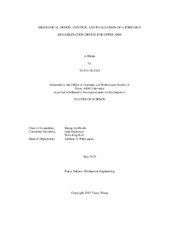Mechanical Design, Control and Evaluation of A Portable Rehabilitation Device for Upper Arm
Abstract
There is a need for functional and effective rehabilitation devices for humans with upper arm injuries. Existing devices are either too heavy, not portable, or do not have 4 degrees-of-freedom (DOF) on the forearm. In this research, a new mechanical mechanism and structure were proposed to cover the full range of wrist and forearm motions as much as possible without sacrificing portability. In addition, the proposed device would have 4 DOF including wrist flexion/extension and radial/ulnar deviation, forearm pronation/supination, and elbow flexion/extension motions. A prototype was developed using 3D printed parts weighing about 840 grams; by comparison, the lightest existing device weighs 2 kg. The portability of the proposed design can increase the flexibility of therapy programs. Experiments were carried out to evaluate the prototype based on workspace, backlash, accuracy, and repeatability. Compared to other devices, the prototype covers all 4 DOF and the motion range coverage ranges from 88% to 100%. These improvements allow the prototype to cover more complicated rehab motions and thereby facilitate performance of difficult daily activities such as rise from a chair and tie a scarf. Experiments results also suggest that the performance of the prototype is very accurate and repeatable. For example, the average backlash is about 1 mm, the accuracy of the device is about ±0.8 mm, and the repeatability is about 0.5 mm.
Future directions include (1) evaluate the effectiveness of the prototype with human subjects, (2) add a human centered sensory and computing device to monitor and provide customized rehabilitation motions.
Citation
Wang, Yunyi (2015). Mechanical Design, Control and Evaluation of A Portable Rehabilitation Device for Upper Arm. Master's thesis, Texas A&M University. Available electronically from https : / /hdl .handle .net /1969 .1 /187000.


